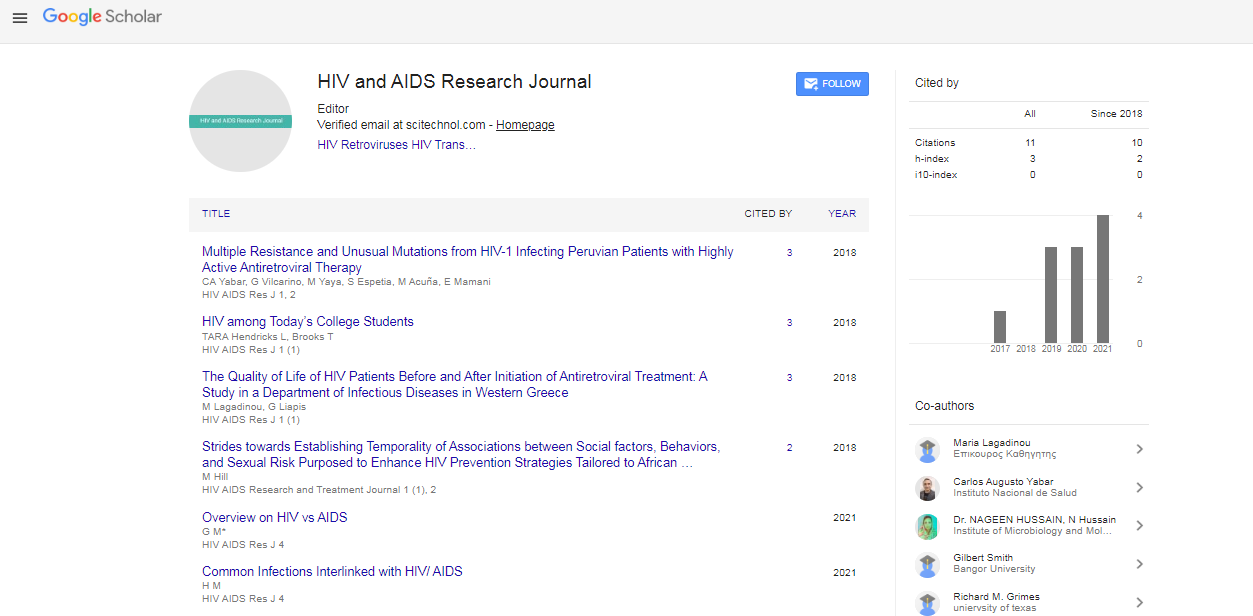Opinion Article, Hiv Aids Res J Vol: 6 Issue: 1
Evolution of AIDS Diagnosis and Its Impact on Public Health
Haili Zhang*
Department of Neurosurgery, Capital Medical University, Beijing, China
*Corresponding Author: Haili Zhang
Department of Neurosurgery, Capital
Medical University, Beijing, China
E-mail: hailizhang@7cmu.cn
Received date: 20 February, 2023, Manuscript No. HARJ-23-93345;
Editor assigned date: 22 February, 2023, PreQC No. HARJ-23-93345 (PQ);
Reviewed date: 09 March, 2023, QC No. HARJ-23-93345;
Revised date: 16 March, 2023, Manuscript No. HARJ-23-93345(R);
Published date: 23 March, 2023, DOI: 10.4172/Harj.1000116
Citation: Zhang H (2023) Evolution of AIDS Diagnosis and Its Impact on Public Health. HIV AIDS Res J 6:1.
Description
Acquired Immunodeficiency Syndrome (AIDS) is a global pandemic that has affected millions of people over the past few decades. While significant progress has been made in the treatment and prevention of AIDS, the disease continues to pose a significant public health challenge. AIDS, or acquired immunodeficiency syndrome, is a chronic and potentially life-threatening condition caused by the Human Immunodeficiency Virus (HIV). The virus attacks the immune system, weakening the body's ability to fight off infections and diseases. Although HIV can be effectively managed with antiretroviral therapy, there is currently no cure for AIDS. HIV is primarily spread through unprotected sex with an infected person, sharing needles or syringes with an infected person, or from an infected mother to her child during pregnancy, childbirth, or breastfeeding. HIV can also be spread through blood transfusions, although this is extremely rare in countries where blood is screened for HIV. Once a person becomes infected with HIV, it can take several weeks for symptoms to appear. Some people may experience flu-like symptoms such as fever, fatigue, and sore throat, while others may not experience any symptoms at all. It's important to note that the presence of these symptoms does not necessarily mean a person has HIV, as these symptoms can be caused by a variety of other illnesses.
Diagnosis
The most common tests used to diagnose AIDS are blood tests that detect the presence of HIV antibodies or antigens. These tests are typically performed in a laboratory setting, and results can take several days to come back.
HIV antibody test
This test looks for the presence of antibodies to HIV in the blood. Antibodies are proteins produced by the immune system in response to the virus. If antibodies are present, it means that the person has been exposed to HIV and their immune system has responded by producing antibodies. Antigen test looks for the presence of antigens, which are proteins on the surface of the virus itself. This test can detect the virus within days of infection and is useful for early diagnosis. CD4 T-cell count this test measures the number of CD4 T-cells in the blood, which are a type of white blood cell that is targeted by HIV. A low CD4 T-cell count is a sign that the immune system is not functioning properly, which is a characteristic of AIDS.
Viral load test
This test measures the amount of HIV in the blood, which can help healthcare providers determine how well the person is responding to treatment.
Without treatment, HIV can progress to AIDS, which is characterized by a severely weakened immune system and a high risk of developing infections and cancers. Common infections associated with AIDS include tuberculosis, pneumonia, and various types of cancer. Fortunately, HIV can be effectively managed with Antiretroviral Therapy (ART), which involves taking a combination of medications that work to suppress the virus and prevent it from replicating in the body. With ART, people living with HIV can lead long and healthy lives and reduce the risk of transmitting the virus to others.
In addition to ART, there are several other strategies that can be used to prevent the spread of HIV. These include practicing safe sex by using condoms, avoiding sharing needles or syringes with others, and getting tested regularly for HIV.
Conclusion
AIDS remains a significant public health challenge, but with continued efforts in prevention and treatment, progress can be made in addressing the pandemic. With early diagnosis and treatment, people living with HIV/AIDS can manage the virus and live long, healthy lives. It is essential to continue raising awareness about the disease and to work towards ending the stigma associated with it. Education and awareness-raising campaigns can help to reduce stigma and discrimination, and support services can provide much-needed care and support to people living with HIV/AIDS.
 Spanish
Spanish  Chinese
Chinese  Russian
Russian  German
German  French
French  Japanese
Japanese  Portuguese
Portuguese  Hindi
Hindi 